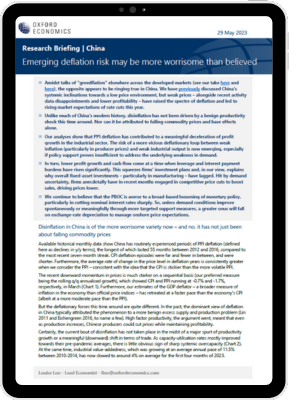China’s emerging deflation risk may be more worrisome than believed

Amidst talks of “greedflation” elsewhere across the developed markets, the opposite appears to be ringing true in China. We have previously discussed China’s systemic inclinations towards a low price environment, but weak prices – alongside recent activity data disappointments and lower profitability – have raised the spectre of deflation and led to rising market expectations of rate cuts this year.
What you will learn:
- Unlike much of China’s modern history, disinflation has not been driven by a benign productivity shock this time around. Nor can it be attributed to falling commodity prices and base effects alone.
- Our analyses show that PPI deflation has contributed to a meaningful deceleration of profit growth in the industrial sector. The risk of a more vicious deflationary loop between weak inflation (particularly in producer prices) and weak industrial output is now emerging, especially if policy support proves insufficient to address the underlying weakness in demand.
- In turn, lower profit growth and cash flow come at a time when leverage and interest payment burdens have risen significantly. This squeezes firms’ investment plans and, in our view, explains why overall fixed-asset investments – particularly in manufacturing – have lagged. Hit by demand uncertainty, firms anecdotally have in recent months engaged in competitive price cuts to boost sales, driving prices lower.
Tags:
Related posts

Post
Understanding Australia’s Goods Trade Dynamics in 2025
2. Explore Australia's goods trade dynamics, with rising exports and falling imports. Learn how global demand impacts the trade balance and future projections.
Find Out More
Post
Roadblocks to China’s chip self-sufficiency dream
China is unlikely to achieve full chip self-sufficiency any time soon because of high technological hurdles in producing advanced manufacturing equipment and materials. The self-sufficiency target now stretches well beyond actual fabrication to include the entire chip supply chain as China struggles to acquire necessary input and machinery into the production process.
Find Out More
Post
Five lessons for businesses navigating tariffs and trade turmoil
In a rapidly evolving global trade environment, businesses must stay ahead of changing tariffs and regulatory demands. Our latest blog offers practical guidance on navigating tariffs, understanding key trade strategies, and leveraging accurate HS code classifications to optimize your supply chain. Explore essential insights that will help your business manage trade uncertainty, ensure compliance, and unlock new growth opportunities.
Find Out More